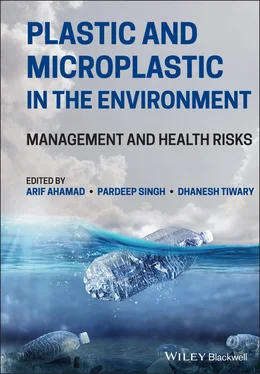Plastic and Microplastic in the Environment
Здесь есть возможность читать онлайн «Plastic and Microplastic in the Environment» — ознакомительный отрывок электронной книги совершенно бесплатно, а после прочтения отрывка купить полную версию. В некоторых случаях можно слушать аудио, скачать через торрент в формате fb2 и присутствует краткое содержание. Жанр: unrecognised, на английском языке. Описание произведения, (предисловие) а так же отзывы посетителей доступны на портале библиотеки ЛибКат.
- Название:Plastic and Microplastic in the Environment
- Автор:
- Жанр:
- Год:неизвестен
- ISBN:нет данных
- Рейтинг книги:5 / 5. Голосов: 1
-
Избранное:Добавить в избранное
- Отзывы:
-
Ваша оценка:
- 100
- 1
- 2
- 3
- 4
- 5
Plastic and Microplastic in the Environment: краткое содержание, описание и аннотация
Предлагаем к чтению аннотацию, описание, краткое содержание или предисловие (зависит от того, что написал сам автор книги «Plastic and Microplastic in the Environment»). Если вы не нашли необходимую информацию о книге — напишите в комментариях, мы постараемся отыскать её.
Thought-provoking discussions of the challenges posed by—and potential solutions to—plastic and microplastic pollution Plastic and Microplastic in the Environment: Management and Health Risks,
Plastic and Microplastic in the Environment
Plastic and Microplastic in the Environment: Management and Health Risks
Plastic and Microplastic in the Environment — читать онлайн ознакомительный отрывок
Ниже представлен текст книги, разбитый по страницам. Система сохранения места последней прочитанной страницы, позволяет с удобством читать онлайн бесплатно книгу «Plastic and Microplastic in the Environment», без необходимости каждый раз заново искать на чём Вы остановились. Поставьте закладку, и сможете в любой момент перейти на страницу, на которой закончили чтение.
Интервал:
Закладка:
1.4.2 Sample Preparation
1.4.2.1 Extraction of Microplastics
Due to the complex nature of the sediment, MPs in the samples must be extracted from sample matrices. The density separation is widely applied to extract MPs from sediment samples. The sediment is dried prior to mixing with a concentrated salt solution. After a period of agitation, MPs and light particles float to the surface or stay suspended, whereas heavy particles settle down (Klein et al. 2018). Many studies extract MPs by using sodium chloride (NaCl) solution since this is inexpensive and environmentally friendly (Alam et al. 2019; Campanale et al. 2020; Free et al. 2014; Mani et al. 2015). However, the density of NaCl solution (~1.2 g/cm 3) cannot extract some polymers such as Polyvinyl chloride (PVC), Polyethylene terephthalate (PET), polycarbonate, and polyurethane. Therefore, sodium iodide (NaI), sodium zinc chloride (ZnCl 2), and sodium polytungstate (Na 2WO 4) are viable choices (Ballent et al. 2016; Ta and Babel 2019; Yin et al. 2020). Conversely, MPs in water samples are easily filtered and separated during the sampling step (Dris et al. 2018).
1.4.2.2 Removal of Organic Debris
The detection of MPs is hampered by organic particles that accompany MPs during collecting water samples. Thus, the removal of the organic debris is important to reduce the misidentification or underestimation of MPs. The detection step is conducted before or after the density separation. Organic debris is usually removed by strong acids (Cole et al. 2014; Imhof et al. 2016) or base solutions (Dehaut et al. 2016), or oxidation agents such as hydrogen peroxide (Ta and Babel 2019; Zhao et al. 2017). Some sensitive polymers (i.e. poly(methyl methacrylate) and polycarbonates) can be lost or damaged during the treatment (Dehaut et al. 2016; Li et al. 2018). Alternate chemicals for removing organic debris in samples are enzymes; these chemicals reduce damage to sensitive polymers. (Catarino et al. 2017; Mani et al. 2015). The method can be conducted by using proteinase K or mixtures of technical enzymes including proteinase, lipase, chitinase, amylase, and cellulose (Courtene‐Jones et al. 2017; Mani et al. 2015). The enzymatic digestion should be conducted under controlled conditions of pH and temperature. However, several disadvantages of using enzymes are reported. In comparison to chemical treatments, enzymatic treatments are expensive, time‐consuming, and may not completely remove the organic material (Courtene‐Jones et al. 2017).
1.4.3 Identification of Microplastic
1.4.3.1 Visual Sorting
In most studies, visual sorting is the first step to separate MPs from samples before identification of the polymer type. Large MPs (> 1 mm) can be recognized by the naked eye (Anderson et al. 2017), while smaller particles are identified using dissection microscopes (Faure et al. 2015; Mani et al. 2015) or scanning electron microscopy (SEM) (Eriksen et al. 2013; Su et al. 2016). This step requires experienced researchers and good optical quality of the microscope. However, identification of all particles is difficult if they are smaller than a certain size, if they are unable to be distinguished visually or cannot be managed with forceps due to their minuteness. Thus, visual sorting is time‐consuming and easy misidentification or underestimation of MPs is possible. Recently, another visual identification method using fluorescence was applied to detect and quantify small MPs. In most studies, Nile Red (NR) was used and dissolved in different solvent solution such as acetone, chloroform, and n‐hexane (Crew et al. 2020; Tamminga et al. 2017). Suspected MPs are stained with the NR solution and analyzed with a fluorescence microscope. This technique is inexpensive, can utilize available instruments, and can be semi‐automated for large amounts of sample analysis.
1.4.3.2 Identification of Microplastics by Chemical Composition
Pyrolysis‐GC/MS
Pyrolysis‐gas‐chromatography/mass spectrometry (Pyr‐GC/MS) can be used to determine the polymer types and additives. In this method, the samples are combusted, and the thermal degradation products of the polymers are used to detect MPs (Fries et al. 2013). The pyrolysis results provide characteristic pyrograms of MPs samples that can be identified by comparing with reference pyrograms of known polymer types. Particles must be inserted in pyrolysis tubes manually, and the technique can analyze only one particle per run; thus the method is unable for analyzing large amounts of samples (Dris et al. 2018; Klein et al. 2018).
Infrared Spectroscopy
The spectroscopic identification techniques consist of Raman spectroscopy and FTIR. These techniques are based on the energy sorption by characteristic functional groups of polymeric materials. Thus, samples must be dried before analysis because water strongly absorbs IR radiation. The purification of samples is important because organic, inorganic–organic, or inorganic may affect the IR spectra of samples. Larger particles (>0.5 mm) may be investigated by FTIR with an attenuated transverse reflection (ATR) unit (Doyle et al. 2011; Klein et al. 2018; Zhang et al. 2015). MPs are manually transferred to the crystal of the ATR unit. The FTIR can be combined with an IR microscope to enhance the identification of small MPs (>10 μm) (Sadri and Thompson 2014). In Raman spectroscopy, the sample is exposed to monochromatic laser radiation. The reaction of the molecules and atoms with the laser radiation cause differences in the frequency of the backscattered light compared with the initial laser frequency. This can be computed to create substance‐specific Raman spectra. Raman spectroscopy is also able to be connected with microscopy. The Raman micro‐spectroscopy can identity very small MPs of sizes down to 1 μm (Yan et al. 2019). Until now, FTIR is widely used in MPs studies.
1.5 Occurrence of Microplastic in Freshwater Environments
In contrast to research in marine environments, MPs in freshwater environments have received less attention, but in the last few years, research on MPs in freshwater are advancing. This helps to reveal the occurrence of MPs in freshwater environments of several continents.
1.5.1 Microplastic in Lakes
MPs have been reported in lakes of Europe, Africa, Asia, and North America ( Table 1.1). In North America, many studies have focused on the Great Lakes system. These studies are clarified by watershed populations, lake areas, and industrial activities. (Anderson et al. 2017; Corcoran et al. 2015; Eriksen et al. 2013). The average number of MPs at the Great Lakes was as high as 193 000 items/km 2(Anderson et al. 2017). In Europe, research on MPs usually relates to population sizes. It varies from the densely populated lakes in Swiss Lake Geneva (Faure et al. 2015) to the less populated lakes such as Italian Lakes Bolsena, Chiusi, and Garda, and Swiss Lake Brienz (Fischer et al. 2016; Imhof et al. 2013). To the extent of our knowledge, the greatest number of MPs in Europe has been reported in Lake Geneva, Switzerland, with 220 000 items/km 2(Faure et al. 2015). Most MP research in Asia is conducted in lakes in China. MPs were found in all study areas from the isolated lakes in Tibetan Plateau (Zhang et al. 2016) to lakes in the most developed areas such as the Taihu Lake (Su et al. 2016). The MPs pollution in China is reported to be more serious than in other regions. Su et al. (2016) found MPs contamination in Taihu Lake with the abundance ranging from 0.1 × 10 6to 6.8 × 10 6items/km 2.
1.5.2 Microplastic in Rivers
The number of MP studies in rivers is mainly in North America and European countries. MPs have been found in rivers in most European countries. MPs were reported in the Tamar River of UK (Sadri and Thompson 2014); in Ofanto River of Italy; in the Rhine River traversing Germany, Netherlands, and Switzerland (Mani et al. 2015); in Swiss rivers (Faure et al. 2015); and in the Seine and Marne rivers of France (Dris et al. 2015). In North America, MPs studies have been conducted in rivers of the United States, such as the Los Angeles basin watershed (Moore et al. 2011), the North Shore Channel in Chicago (McCormick et al. 2014), and the Detroit and Niagara Rivers (Cable et al. 2017), as well as the St. Lawrence River of Canada, (Crew et al. 2020). In Asia, most studies are carried out in the East region of the continent. MPs were found in many river systems of China such as Yangtze and Pearl (Yan et al. 2019; Zhang et al. 2015), and the Tamsui River of Taiwan (Wong et al. 2020). Similar to results from lake studies, the abundance of MPs found in river systems of China was much higher than in other areas. At the Yangtze River, the mean number of MPs was reported at 8.5 × 10 6items/km 2. Another study at Pearl River found 19860 items/m 3. In river studies, the abundance of MPs is reported in different units. Some studies presented the number of MPs per filtered volume of water (items/m 3), while others presented it per area of water surface (items/km 2). Thus, the comparison between studies is difficult.
Читать дальшеИнтервал:
Закладка:
Похожие книги на «Plastic and Microplastic in the Environment»
Представляем Вашему вниманию похожие книги на «Plastic and Microplastic in the Environment» списком для выбора. Мы отобрали схожую по названию и смыслу литературу в надежде предоставить читателям больше вариантов отыскать новые, интересные, ещё непрочитанные произведения.
Обсуждение, отзывы о книге «Plastic and Microplastic in the Environment» и просто собственные мнения читателей. Оставьте ваши комментарии, напишите, что Вы думаете о произведении, его смысле или главных героях. Укажите что конкретно понравилось, а что нет, и почему Вы так считаете.












